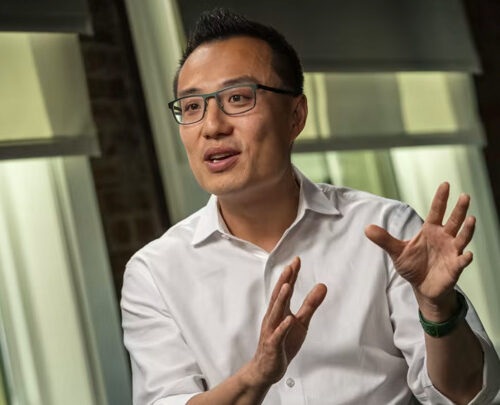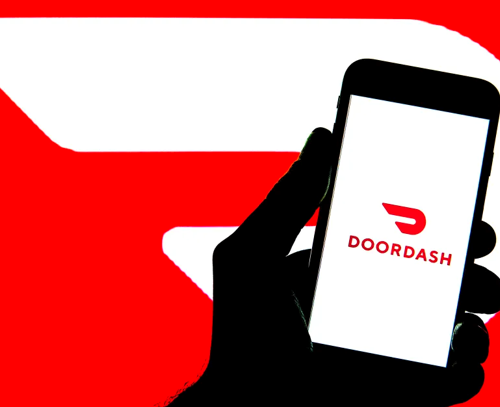With Instacart filing to go public, other grocery delivery services are scrambling to keep up with one of the grocery delivery leaders.
At the same time, DoorDash has revamped its alcohol delivery policy in some markets, hoping to prevent underage drinking on college campuses.
As Instacart IPO Looms, DoorDash CEO Says Grocery Delivery Needs to Improve
Topic Originally Appeared On Barrons
Summary
While Instacart parent Maplebear inches toward an initial public offering, one of the company’s primary competitors took some time on Tuesday to raise some questions about the grocery-delivery experience for consumers more broadly.

Tony Xu, CEO of DoorDash — David Paul Morris/Bloomberg
Speaking at the Goldman Sachs technology conference in San Francisco, DoorDash (ticker: DASH) CEO Tony Xu asserted that while there is a big “underpenetrated” opportunity is grocery delivery, consumers view the customer experience as “worse than the physical experience of buying your own” goods at the store.
While best known for its arm that delivers restaurant food, DoorDash offers several ways to get groceries delivered via online ordering.
My Take
Instacart moving forward with going public is throwing a wrench in the mix for competitors like DoorDash that are already public but trying to break into the grocery delivery market. DoorDash is one of the leading delivery services out there, but Instacart has them beat in terms of grocery delivery. DoorDash wants to change that, understandably.
DoorDash is still relatively new to the grocery delivery game, breaking into it as recently as February of this year. Read up on their start here: DoorDash breaks into grocery delivery.
DoorDash Makes Major Change To Its Delivery Policy, And Certain Customers Will Not Be Able To Order
Topic Originally Appeared On The Sun
Summary
Some customers living on college campuses will no longer be able to place certain orders.

DoorDash has introduced strict new measures in Massachusetts to prevent underage alcohol sales.
The Bay State has a high concentration of college students, and those living on campus will no longer be able to place alcohol orders.
DoorDash is also giving delivery drivers further compliance training to spot underage customers on delivery.
My Take
It makes sense what they are trying to do, but isn’t it already required for customers to provide their ID at delivery? College students who are of age and on a wet campus should be allowed to order alcohol for delivery if they want. And not delivering because it’s a college campus isn’t really going to prevent underage drinking.
Obviously, it’s great to try to take steps to prevent underage drinking, but everyone knows you can’t really prevent college kids from obtaining alcohol when they want to.
It is nice, though, that DoorDash is going to be making it easier for drivers to return alcohol orders if the delivery cannot be completed. I know this has been a sticking point for some drivers ever since alcohol delivery has been a thing. You’re not supposed to deliver to someone who is clearly already intoxicated, but if it’s hard to return the alcohol, what can a driver really do? This change is definitely for the better.
What do DoorDash alcohol delivery drivers think of the changes in the article? Do you think it’ll help you as a driver?
Does Empower Pose A Mortal Threat To Uber And Lyft?
Topic Originally Appeared On Washington Examiner
Summary
Ride-sharing giants Uber and Lyft have attracted hundreds of millions of customers across the globe. They have done so by undercutting the price points offered by taxi companies. While taxis can still be cheaper than Uber and Lyft during “surge pricing” periods (when the supply-demand curve carries the price point higher), their best days are gone.
But now, Uber and Lyft are facing their own market disrupter, one that potentially poses a mortal threat to their business models. Enter Empower. It’s a recent ride-sharing market entrant that tends to be significantly cheaper than its older competitors.
My Take
RSG’s Sergio has written a review of Empower: Empower Rideshare App Review 2023. The biggest difference between Empower and its main competitors, Uber and Lyft, is that Empower is subscription-based. The driver retains all their fare and simply pays a monthly fee. But it’s also still on the newer side and likely working through some kinks.
Not all drivers are willing to pay a subscription to become a driver unless they are guaranteed a minimum earnings. If you’re not earning more than your subscription costs, what’s the point? As Empower becomes bigger, spreads to more cities, and is more recognized by the public, it could prove to be a threat. But it will take time.
Lyft Is Becoming More ‘Customer-Focused’ For Riders, Drivers: CEO
Topic Originally Appeared On Yahoo Finance
Summary
While Lyft and Uber are considered by many to be natural rivals in the ride-share space, Lyft CEO David Risher cites certain post-COVID cultural trends to be detrimental to the overall ride-share and experience industries.
Risher sits down with Yahoo Finance Executive Editor Brian Sozzi at the Goldman Sachs Communacopia & Technology Conference to discuss Lyft’s refocusing on its customers and costs.
“Our strategy is to really… make price shopping kind of a waste of time, if I can say it that way,” Risher says. “I want to focus on our customers, and sometimes what I say is, I don’t think our big competition is Uber. I think our competition is staying at home, watching Netflix and eating pizza. I mean, as much fun as that is, I guarantee it’s more fun to go out with a friend.”
My Take
I mean, he does have a point. I haven’t used Uber or Lyft nearly as much since the pandemic, but also, during that time, I moved to an area of the state where Uber and Lyft do not have active drivers. I have to drive 30 minutes before I can even find an available driver. But also, we’ve all gotten very used to entertaining ourselves at home for cheap or free, without the need for ordering an Uber or Lyft to get out of the house.
But also, when people do decide to leave the house and order a rideshare, they want it to be worth the money. If one platform is significantly higher cost than the other, the cheaper option will likely be chosen more often than not.
But let’s see what a customer-focused Lyft can look like. We haven’t seen that in a long while. Also, maybe start focusing on what’s best for your drivers.
Former Uber Exec Explains How To Turn Failure Into Innovation
Topic Originally Appeared On Youtube
Summary
“You’re not punished for failing, you’re punished for not trying.” Former Uber exec Emil Michael on how to truly achieve success.
Looking to bring Emil Michael’s insights to leaders across your company? Great. This video is part of an 11-part expert class on emotionally intelligent leadership, and it’s available to organizations that subscribe to Big Think+.
RSG in the News This Week
Read more trending topics in the news this week:




